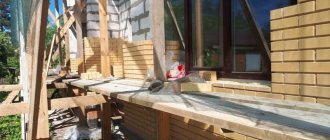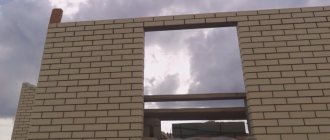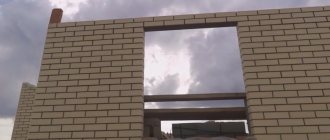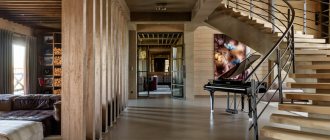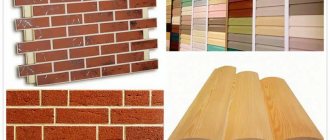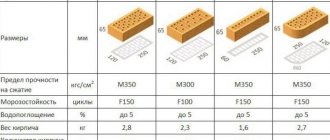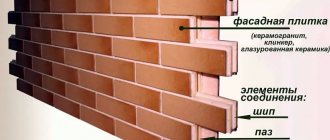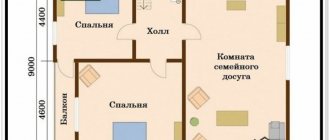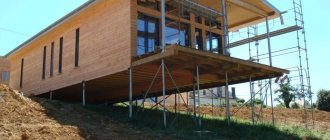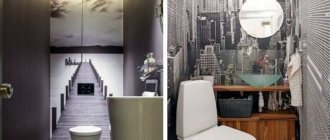Today, a huge number of materials have been created that are used to decorate the facades of houses. But brick remains the most reliable, durable and attractive. Thanks to the wide range, property owners have almost limitless possibilities in their cladding. Some choose a monochromatic finish, while others prefer to decorate the facades with materials of different shades and textures.
Types of facing bricks
Today on the market you can find a large number of varieties of facing bricks, which differ in composition and manufacturing method. At the same time, their characteristics are at a high level. The difference is only in color and appearance. The most popular options include:
- Ceramic brick. Several types of clay are used for its production. The material can be solid or have cavities inside that improve thermal insulation properties.
- Clinker. It differs from ceramic in that refractory types of clay are used for its production. Due to the complex production process, such material will be more expensive.
- Hyper-pressed. It consists of limestone, slag, waste obtained from stone processing, shell rock and cement. Its cost is relatively low.
- Silicate. It consists of quartz sand, lime, mineral additives and pigments. This material is the cheapest among other types of facing bricks. It is used extremely rarely for facade decoration, since it is able to absorb moisture, reacts poorly to severe frosts and is not resistant to ultraviolet radiation.
What is Bavarian masonry?
As mentioned above, bricks from different batches differ significantly in color. In the 17th century, the Bavarians also faced this problem. They tried to select raw materials more carefully and constantly improved the manufacturing process, but nothing worked.
Then it occurred to me to sort the finished products by color. Unfortunately, the desired result also did not happen. There was nothing left to do but mix all the elements of 2-4 shades and distribute them evenly over the façade so that light or dark areas do not form on the surface.
Builders noticed that houses with such a pattern looked no worse than plain buildings. In addition, the masonry gave the building brightness and attractiveness, making it stand out from the crowd. Now this style of bricklaying is considered a sign of good taste, and tourists go to Bavaria to admire the ancient buildings.
Brick house styles
Facing brick is not only a very durable and practical material. Thanks to the variety of its types, it successfully competes with other trendy finishing options and is suitable for decorating any style of building.
Baroque
This design style is called one of the most noble. Majestic designs with refined curves allow you to create an atmosphere of luxury. This design option is chosen by those who want to show their individuality.
Castle style
Gothic home decoration is suitable for romantics. Its distinctive features are towering vaults, huge windows, and tall towers. All this makes the building look like a fairy-tale castle. A home in this style will be complemented by well-groomed lawns and flowering flower beds.
Classic style
For those who value tradition, decorating the facade of the house in a classic style is suitable. There should be no trendy materials here. The main design rule is the combination of correct proportions in everything.
Modern
Calm styles in the design of facades include modern. Its characteristic complex and at the same time refined lines, as well as plant patterns, make the house cozy and attractive.
High tech
Those who want to make their home look like an office space choose high-tech design. This makes it possible to combine brick with glass and metal elements, as well as bring the most daring ideas to life. The uniqueness of the house is emphasized by modern designs combined with non-standard solutions.
Marking
Facing bricks are marked using an alphanumeric designation. The larger the number in the product name, the better its characteristics:
| Options (brown, red) | Unit | Fas. M-100 products | M-125 | m-150 |
| Compressive strength limit | kgf/cm2 | 100-120 | 130-145 | 155-170 |
| Flexural strength limit | kgf/cm2 | 16-18,5 | 19-20,5 | 21-22,5 |
| Water absorption | % | 8,5-10,5 | 8,5-10,5 | |
| Average density | kg/m2 | 1100-1280 | 1180-1230 | |
| Thermal conductivity | W/(m-K) | 0,37 | 0,37 | |
| Frost resistance | cycle | 50-100 | 50-100 | |
| Emptiness | % | 36-38 | 36-38 | |
| Product weight | kg | 1,500-2,300 | 2,300-2,400 | |
| Dimensions | mm | 250x120(65)x65 | 250x120x65 | |
| Number of bricks on a pallet | PC. | 480 | 480 | |
| Dimensions of packaging | mm | 1000x1000 | 1000x1000 | |
| Parameters (dark peach, light peach, cream) | Unit | Fas. M-100 products | M-200 | M-250 |
| Compressive strength limit | kgf/cm2 | 100-120 | 210-230 | 255-300 |
| Flexural strength limit | kgf/cm2 | 16-18,5 | 25-28,5 | 29-33 |
| Water absorption | % | 8,5-10,5 | 5,5-7,0 | |
| Average density | kg/m2 | 1100-1280 | 1255-1280 | |
| Thermal conductivity | W/(m-K) | 0,37 | 0,37 | |
| Frost resistance | cycle | 50-100 | 50-100 | |
| Emptiness | % | 36-38 | 36-38 | |
| Product weight | kg | 1,500-2,300 | 2,450-2,500 | |
| Dimensions | mm | 250x120(65)x65 | 250x120x65 | |
| Number of bricks on a pallet | PC. | 480 | 480 | |
| Dimensions of packaging | mm | 1000x1000 | 1000x1000 | |
Painting the brick facade of a house
If you want to transform the brick facade of a building, you can paint it. In this case, both the entire wall and its individual sections can be painted. In addition to the aesthetic function, painting also has a protective function. Modern paints and varnishes are able to withstand significant temperature fluctuations, protect from wind, precipitation, ultraviolet radiation and other atmospheric influences.
Painting is carried out only 1 year after facing the facade. The sequence of work is as follows:
- the brickwork is cleaned of possible contaminants, such as fungus, mold, etc.;
- the wall is washed with soapy water;
- the washed surface should dry for 1-2 days;
- the wall is treated with a special primer;
- The selected paint and varnish composition is applied to the brickwork.
Roof color selection
Before deciding on the final color of the facade, you need to choose a bloody design.
Californian physicists have come to the conclusion: in large cities, the roofs of buildings should be decorated in light colors. Light colors reflect sunlight, dark colors absorb sunlight. Lightweight roofs reduce air conditioning costs in summer and reduce the greenhouse effect in the atmosphere. Lighter roofs will significantly reduce carbon emissions.
This is a scientific view of reality. In practice, lightweight roofs can only be seen in winter, when they are covered with snow; they are not popular.
It’s worth starting with the choice of roofing when choosing exterior finishes. This principle dictates a narrow range of shades in which roofing materials can be selected. This does not mean that houses are doomed to monotony. Manufacturers of roofing felt are constantly expanding their offer with new color solutions.
The color of the roof and walls of the house should match well, for example:
- beige, yellow, white walls are suitable for a green roof;
- a traditional red roof covered with reddish tiles will give the building a classic look that matches the white and cream facades;
- It’s not difficult to choose universal gray siding - all colors match gray, as well as wooden cladding elements: doors, windows, terraces; gray roofs combined with pastel-colored walls look modern and tasteful
The darker the roof, the more open space there should be around the building; dark roofs look good in areas with low density and sparse vegetation.
Methods for laying facing bricks
The durability of the material and the overall appearance of the building will depend on the chosen method of laying facing bricks. In addition to the classical method, other, more original options are often used today:
- block masonry;
- savage;
- track;
- crosspiece;
- Gothic masonry.
In addition, there are other options for laying the material, which allows you to use the most suitable option in a particular case.
Cladding rules
When decorating a facade with facing bricks, you should remember a number of rules:
- the upper and lower masonry are complemented by a ventilation gap to remove moisture;
- when using several types of bricks, a trial row is necessarily formed;
- You can only work with the material at temperatures above zero;
- for cutting products, a grinder equipped with a special disk is used;
- before starting laying, it is necessary to temporarily place the brick in water so that it does not draw moisture out of the mortar;
- the finished seam should not protrude beyond the plane of the wall;
- after finishing is completed, it is necessary to treat the facade - for example, with a 10% solution of perchloric acid, which will help clean the remaining solution from the masonry;
- a wall made of facing bricks must be located on a foundation.
The finishing must be attached to the facade. If this is not done, over time the cladding will begin to shift and collapse. There are many ways to attach finishing bricks - for example, plaster mesh or metal rods. Another mounting option is dowels with a diameter of 6 mm driven into the wall. A wire is tied to their caps, and its ends are inserted into a cement solution. This operation must be repeated every four vertically laid bricks.
Designers do not recommend
The desire to make your home stand out from others should not lead to fashion failures. Don't neglect the basics of shade.
To avoid excessive overflow, use no more than two colors, and in all other cases trust the designers.
The most harmonious color combinations for facades and roofs
Before you get confused about your home and roof color choices, it's a good idea to familiarize yourself with the laws in your area. It is quite possible that the acceptable color schemes for finishing buildings have already been prescribed.
A striking example of this is French Provence. By decision of local authorities, all houses on the territory are faced exclusively with red and orange tiles. This was done in order to preserve the historical appearance of the area and preserve its unique ethnic flavor. If there are no restrictions, here you can give scope to your imagination.
According to the designers, houses in which a white, lemon or light gray facade is crowned with a green roof will always be harmonious. These buildings will be a wonderful addition to the natural landscape.
Simple, but, as they say, yellow, cream, beige walls of the house, assembled under a brown roof, look tasteful.
The gloomy impression of a black and gray roof is well diluted with blue, green, and white walls. These are quite rare exclusive combinations in our area. Houses in such a contrasting design look rich and noble.
A red roof floating between its brown and gray counterparts won't turn your home into a black sheep. In such a context, a surprising solution would be quite appropriate. The red color will not only unobtrusively make your home stand out from the crowd, but will also emphasize the solidity of the building.
Color psychology
“Decorate the walls of your house and its roof with colors that suit your character.”
Scientists have long developed a theory that colors affect a person’s mood, and according to it, any nuances that appear in the field of vision affect the psycho-emotional state, including the background of the walls of the house in which we live. This means that you should decorate the walls of the house and its roof with colors that suit your character.
Conservatives will like the combination of a dark roof with a light facade. This is a traditional and therefore frequent duet. For the owner, this is reassuring, allowing him to feel relaxed and protected in the house.
A light roof with a dark facade will attract innovators and daredevils. Houses with this design are very rare. It seems that the buildings simply dissolve into the surrounding world. Everything looks very harmonious and peaceful.
Calm people will prefer design to the spectrum of the house and roof. Such decor will not cause irritation and will not get lost in the general background of the landscape. If you want to diversify the finish, you can add sections of rustic stonework or original trim to the façade.
Unacceptable Practices
The following decisions will lead to deterioration in the appearance of the building:
- more than 4-5 colors in wall decoration . The result may surprise you, but it is unlikely to please you.
- Using incompatible or several bright shades that interfere with each other.
An error in choosing a color worsens the perception of a home Source doka-metal.ru
- The facade and roof should be made in either warm or cool colors ; otherwise there will be no harmony.
- Using the same color .
- Not the best solution is to copy the decoration of neighboring houses . It is enough to choose colors that match the tone or style.
- If you want to focus on small details (door and window frames, cornices, pipes), use one shade so as not to create the impression of variegation, which is tiring for the eyes.
- To prevent your home from looking like a children's construction set (unless you're going for that effect), the ideal accent colors are white, black, and gray , rather than red, blue, or yellow.
For a black facade, the main thing is accents Source otdelka-trade.ru
Advantages and disadvantages of this finish
When choosing materials for decorating a facade, you should definitely study all the pros and cons of one or another option. Consult with professionals, contact home owners who have chosen the same finish and know how the material behaves. Internet forums are also suitable.
It is advisable to visit third-party sites, and not the online store of any manufacturer.
As for brick cladding, the following advantages are highlighted:
- High moisture repellency.
- Durability and reliability.
- Frost resistance of the structure.
- Vapor permeability.
- Fire and environmental safety.
- Long service life of 50 years.
- Self-cleaning - dust and dirt are washed away by rainwater.
- Easy care.
- Versatility of use - suitable for both outdoor and indoor decoration.
- Large selection of shades and textures.
Of course, there are several disadvantages , like any other finishing material. Let's get acquainted with them:
- High price.
- Low-quality products are covered with a white coating (efflorescence).
It is important to buy the right amount of bricks from one batch, otherwise the elements will differ in color. Although some people specifically buy 2-3 shades and mix the elements during the styling process. Thus, a unique pattern is created on the facade.
After evaluating the information received, everyone decides for themselves whether this option is suitable or not.
Harmony with natural landscapes
When you think about the color of your house and roof, think about what trees and plants you will plant next.
And if the construction area is already surrounded by a certain landscape, then there are two combination options. The first is merging with the surrounding nature - as a result, choosing solid colors, the second is highlighting the house against the general background - contrasting tones.
